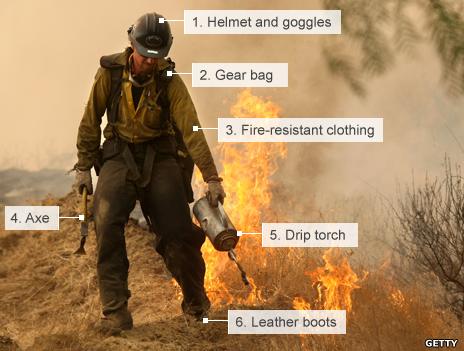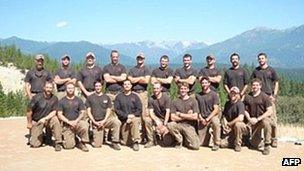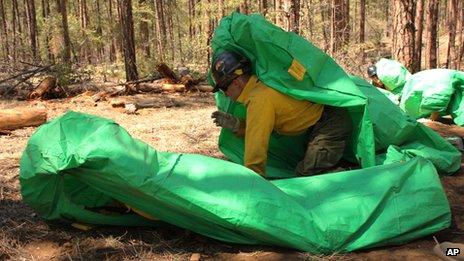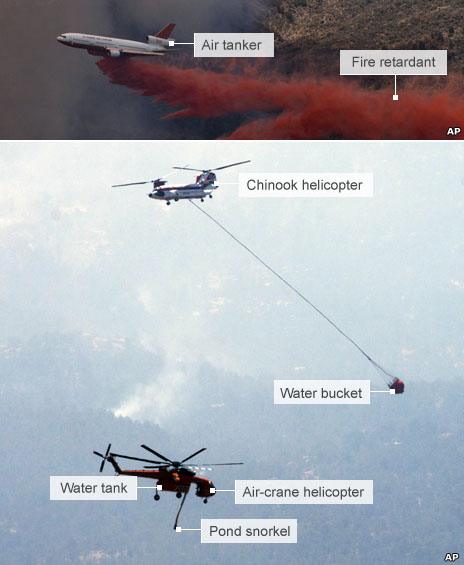Arizona wildfire: Battling the blaze
- Published

The 19 firefighters killed in Arizona's wildfire were part of an elite crew known for tackling the area's worst blazes.
The interagency "hotshot" team - of which there are a number across the US - are highly trained and equipped to work in remote areas at ground level for long periods with little support.
Under heavy protective clothing, their main task is to create a firebreak between people and the fires by removing brush, trees and anything that might burn in the direction of homes and cities.
To achieve this they carry a range of equipment.

Hotshot firefighter kit

1. Helmet and goggles: fitted with protective flaps to cover the face if needed
2. Gear bag: containing water, rations, sleeping bag and fire shelter, among other things
3. Fire-resistant clothing: shirt, trousers or pants and gloves. Crews also have yellow jackets with flourescent strips for high visibility
4. Axe or "Pulaski": a combination of an axe and a hoe for clearing trees and vegetation
5. Drip torch: used for lighting smaller fires along a control line to consume the fuel of the main fire
6. Leather boots: without steel toe caps, which attract and retain heat


The dead firefighters were identified as members of the Granite Mountain Hotshot crew
Fire shelters
Art Morrison, of the Arizona State Forestry Commission, told CNN the hotshot crew in Arizona was "digging a fire line" - removing fuel from the path of a wildfire - when the fire overtook them.
The team - without anywhere to escape - was forced to deploy emergency shelters, intended to shield them from the fast-moving flames, he explained.
The shelters - made of a fire-resistant material - are regarded as the last line of defence for a firefighter against advancing flames. Firefighters are advised to dig a hole and climb into it inside the protective tent, allowing the fire to pass over them.
However, Dan Fraijo, fire chief in the Arizona city of Prescott, said there was only a "50% chance" of survival.

Emergency shelters are a firefighter's last line of defence
About 200 firefighters are continuing to fight the Arizona wildfire - started by a lightning strike - and more crews are on their way.
They will include helicopters and other aircraft, which can drop thousands of litres of water or fire-retardant chemicals from low altitude.
"Smokejumpers" - rapid-response units who parachute into inaccessible areas to tackle blazes - are also often deployed.

Firefighting from the air

Fixed-wing aircraft are used to drop off teams of smokejumpers and large air tankers and transport aircraft are also used to drop fire retardant
Helicopters are used to drop water, transport crews, deliver resources and for reconnaissance
Some can drop water from water buckets suspended on wires, while others, such as the air-crane, have their own on-board "belly tanks" filled via a snorkel that extends below the helicopter

Despite their skill, the difficulty of the firefighters' task is often directed by the weather.
The most damaging fires occur in hot, dry and windy conditions. Gusty winds can cause large fires to "leap" across fire breaks and high temperatures and drought prolong a fire's life.

How wildfires spread

A fire needs fuel, oxygen and heat to burn. The fire threatening the town of Yarnell was started by lightning and spread rapidly in the very hot, dry conditions, fanned by strong winds
The fastest-moving and most dangerous part of the fire is known as the "head". Areas ahead of the fire are warmed as it approaches and flying embers blown by the wind spark spot fires, which cause it to leap further ahead
Some vegetation or fuel will burn quicker than others and this creates "fingers" of flame which, in turn, create pockets of land surrounded by fire, making it harder to tackle
Fires travel faster uphill than downhill, as the heat and smoke rise, heating areas higher up the hill and wind currents also tend to blow uphill, pushing the flames further. Burning embers may roll downhill, starting new fires

Another technique sometimes employed by firefighters is a "backfire" - creating a controlled blaze to either clear dry woodland and starve the fire of fuel, or with the aim of joining up with the main blaze so the combined fire burns itself out.
- Published1 July 2013
- Published1 July 2013
- Published1 July 2013
- Published30 June 2013